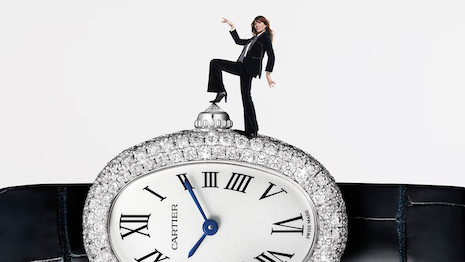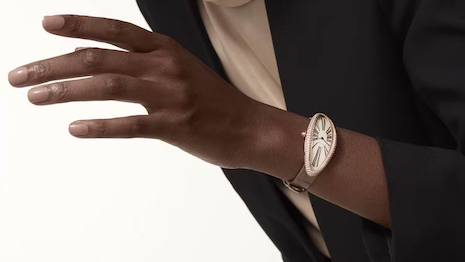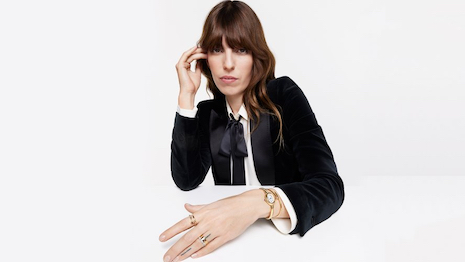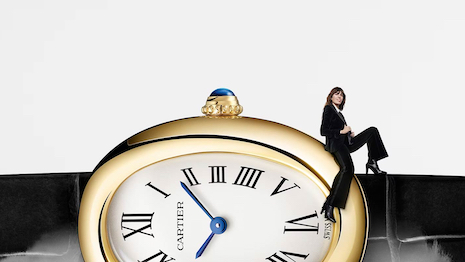 Fifty years after the birth of the Baignoire collection, the brand brings the style back to life with new design codes. Image credit: Cartier
Fifty years after the birth of the Baignoire collection, the brand brings the style back to life with new design codes. Image credit: Cartier
French jewelry maison Cartier is getting after the affluent, propping up hard luxury in a new marketing push.
The house is keeping heritage close while paring down proportions on a classic, bringing its Baignoire timepiece back to life 50 years later. Actress, model and musician Lou Doillon stars in the accompanying campaign, wrapping Cartier's gifts in a certain “je ne sais quoi” as the brand targets clients at the top of the food chain.
“Hard luxury has continued to soar, and blue chip Cartier, the crown jewel in Richemont's luxury stable, continues to make all the right moves, leaning into increasingly higher ends of the luxury sector, while embracing its loyal consumers and simultaneously attracting aspirational luxury acolytes through its invigorated social media,” said Reginald Brack, a watches & luxury industry advisor based in Detroit.
Mr. Brack is not affiliated with Cartier, but agreed to comment as an industry expert.
Measuring up
Emblematic of the house’s watchmaking capabilities, Cartier's creation has technically been around for a minute.
The piece at hand is rooted in a design story that began in the 20th century. The debut of Ovale cintré in 1958 predates a rebrand that would cause the Cartier unit to adopt a new name.
In 1973, the Baignoire was officially born. Modern-day, the crown jewel is the subject of Cartier's most recent digital expression.
Scaling the Baignoire collection, a new Cartier ad plays with proportions
A refreshed Cartier Baignoire preserves the original timepiece’s classic ovular shape, opting instead for updated encasings.
Signature details include a domed watch crystal, one that offers a clear view of the Roman numerals underlining the Baignoire’s dial. As shown by France’s Ms. Doillon in a series of new slots, modernized dimensions keep time using a miniaturized case.
Materializations range — a “Mini Baignoire” rose gold model with an alligator-skin strap and base features makes a starting ask of $10,100. From here, price points ascend.
Diamond-encrusted case perimeters place the next group of “Allongée” options incorporating Dalí-esque stretched faces in the center of the bunch cost-wise, the most valuable ringing in at $53,500.
The assortment tops out at a little over $75,000 -- the Mini Baignoire’s white gold bracelet is set with 834 brilliant-cut diamonds totaling 3.13 carats.
 Set with 834 brilliant-cut diamonds, the Baignoire Allongée watch in extra large features an 18-carat rose gold case. Image credit: Cartier
Set with 834 brilliant-cut diamonds, the Baignoire Allongée watch in extra large features an 18-carat rose gold case. Image credit: Cartier
Cartier’s lead carries the watch styles well.
The descendant of a name that has reached the height of luxury — the multihyphenate muse’s mother, a fashion royal of sorts, has passed the torch — Cartier’s chosen talent covers the effort in elegance.
“Cartier's choice of Lou Doillon as the freshest face of the storied brand's Baignoire line makes complete sense,” Mr. Brack said.
“The daughter of Jane Birkin (which the undisputed most sought-after luxury item, the Hermès Birkin bag, is named for), she has a built-in luxury pedigree and international luxe appeal.”
Scaling back
Cartier’s latest collection beelines for those at the highest end of the luxury segment, bypassing aspirational shoppers.
From first-time buyers yielding stimulus checks and surplus savings post-pandemic to spenders opting for lower-ticket, entry-level products to match more modest incomes, these customers tend to be the first to dial back dollars at early signs of economic recession.
Make no mistake, consumers at both ends of the spectrum have undeniably fueled the growth of the luxury goods market over the last decade. Despite gains, the accessibility pendulum on high-end goods seems to be swinging in the opposite direction.
 French actress Lou Doillon stars in Baignoire campaign imagery. Image credit: Cartier
French actress Lou Doillon stars in Baignoire campaign imagery. Image credit: Cartier
Earlier this year, Saks’ chief marketing officer Emily Essner spoke to the new reality, as it relates to the U.S. retailer’s Pulse Survey, which profiles the luxury consumer quarterly (see story).
“When we look a little lower [in household income], [and] ask that question ‘how are you planning to spend in luxury,' we are seeing a little bit of a softening,” Ms. Essner said.
The industry is making adjustments in the face of these facts. According to new data, those seeking peak personal goods are taking a “less but better” approach (see story).
Federica Levato, partner at Bain & Company, Milan, in June, recently shared insights with Luxury Daily, describing a cross-category “quest for elevation” currently at play, driven by iconic and uber-lux pieces.
“Timeless and iconic pieces continue to drive market growth as a consolidated asset class, due to their scarcity and continuous appreciation,” Ms. Levato said.
These insights render Cartier’s apparent merchandising and marketing strategy sound, as many labels pivot toward hard luxury, a bracket that includes handbags, high jewelry and, of course, watches.
 Cartier's campaign lead wears a brand classic across a set of contemporary scenes. Image credit: Cartier
Cartier's campaign lead wears a brand classic across a set of contemporary scenes. Image credit: Cartier
Leading the storytelling exercise with ancestral energy could certainly help, as part of Cartier’s value proposition lies in its age, a central point for much of its consumer-facing language.
On a macro level, Richemont’s position is boosted by a number of legacies like this. Belgian subsidiary Delvaux, for example, is the oldest luxury leather goods maison in the world.
The parent company profile offers the French jeweler a promising foundation, all factors considered, though the Cartier Baignoire collection must now find its footing amid fairly uncertain market conditions. As far as revamped exclusives' future sales are concerned, time certainly tells all.